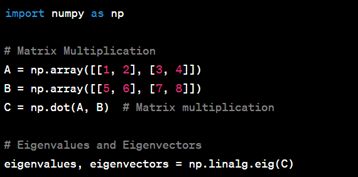Investigating NumPy: The Foundation of Python’s Numerical Computing

Investigating NumPy: The Foundation of Python’s Numerical Computing
What is NumPy?
The Python software package known as NumPy, or Numerical Python, is essential for scientific computing. It supports multidimensional arrays and matrices and offers a range of mathematical operations to effectively work with these arrays. With the help of NumPy, you may manipulate data in complex ways by executing mathematical and logical operations on arrays.
What Is NumPy Used For?
Speed and Efficient Execution: NumPy is implemented in C and Fortran, ensuring exceptional speed for numerical operations. It is made to efficiently handle big datasets and challenging mathematical procedures.
Operations on multidimensional arrays: NumPy offers a robust N-dimensional array object that may be used to carry out a variety of operations on arrays, such as sorting, shape, indexing, and more, all in an efficient way.
Mathematical Functionality: NumPy provides a large selection of mathematical operations that can be used with arrays, making it a crucial library for jobs involving numerical analysis and calculation.
Integration with Other Libraries: The basis for data analysis, scientific computing, and visualization is formed by NumPy’s smooth integration with other Python libraries like SciPy, Pandas, and Matplotlib.
Alternatives to NumPy:
While NumPy is a well-liked option for Python’s numerical computation, there are other libraries that fulfill comparable functions:
Pandas: Pandas are mostly used for analyzing and manipulating data. It offers higher-level data structures built on NumPy, which makes working with labeled data simpler. Pandas are frequently used for data analysis, data transformation, and data cleaning activities.
TensorFlow: TensorFlow is a robust open-source library created by Google for use in projects involving deep learning and machine learning. With an emphasis on creating and training neural networks, it provides a capability that is comparable to NumPy, especially in managing multidimensional arrays and performing mathematical operations on them.
Just-In-Time (JIT) compilation and automated differentiation are the main focuses of JAX, which is gaining popularity for its ability to speed up NumPy programs. It offers GPU/TPU acceleration and better speed for complicated computations and is frequently used for high-performance numerical computing and machine-learning workloads.
Benefits and Drawbacks of NumPy
Advantages:
- Managing big datasets and difficult mathematical processes effectively
- Extensive collection of scientific and mathematical functions for a variety of activities
- Because it was implemented in C and Fortran, it was enhanced for speed and performance.
Disadvantages:
- Due to its low level and complexity, the learning curve for novices is steeper.
- Limited support for non-numeric data types might be limiting for some data processing activities.
Future NumPy’s range:
NumPy is still developing, and there are several possible areas for expansion:
Performance Improvement: Continued optimization work to boost efficiency and benefit from hardware and parallel computing developments.
Advanced Functionality: Increasing the functionality of the library to meet new requirements in scientific computing and data analysis, maybe including better support for parallel computing and GPU acceleration.
Improve accessibility and user experience by upgrading documentation and offering more user-friendly interfaces for complicated tasks.
Examples include making and modifying arrays:

Examples include Linear Algebra Operations:

Conclusion
As a key part of the Python scientific computing ecosystem, NumPy offers a solid framework for managing challenging numerical computations and data analysis tasks. It is an indispensable tool for numerous scientific and engineering applications due to its effective array manipulation capabilities and wide range of mathematical functions. Although there are alternatives, NumPy has a stronghold in the field of numerical computing and data analysis, and its ongoing improvements guarantee this. NumPy is a constant companion for those exploring the worlds of data-centric scientific exploration and computation as the Python ecosystem develops.
In a nutshell, if you developed a keen interest in learning Python with deep essence, then you may go for the Best Python Training Institute in India that is Craw Security, which is also the Best Cyber Security Training Provider in India with its highly credible and lucrative training programs. To know more about the same, give us a call at +91-9513805401 and have a word with our highly skilled educational counselors.
















